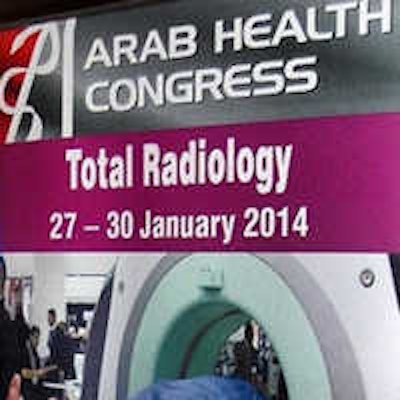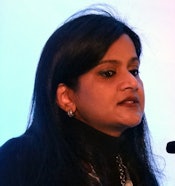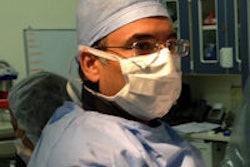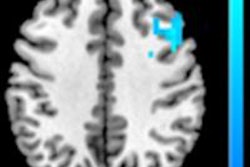
DUBAI - Even in the best of circumstances, setting up a radiology resident training program can be a challenge. But for a large regional hospital in the Middle East with a transient international staff and no experience or particular preferences with regard to training, the job can be more than daunting.
"For us who are program directors, to train the new generation to become radiologists is the most important task," said Dr. Naghma Nawaz.
Far from radiology's most established training regimens, the way forward wasn't clear for the radiology faculty at Sheikh Khalifa Medical City (SKMC) in Abu Dhabi, United Arab Emirates.
"We had a faculty of eight different nationalities from six different radiology training systems," said Nawaz, who is deputy chair of radiology and resident program director for the sprawling regional facility.
Also, like other hospitals in the region, SKMC has high staff turnover: More than half the faculty has changed in the past four years.
SKMC also manages a group of peripheral clinics that performed approximately 190,000 imaging exams in 2011, she said. Its outsized radiology department comprises nine x-ray rooms, seven ultrasound scanners, two mammography machines, high-field MRI scanners, two gamma cameras, and three CT scanners.
But it lacked a resident training program, so the department decided to set one up in 2009, making it the second UAE hospital to establish a large residency program.
How to proceed?
The challenges included forming a unified curriculum: Should it be based on the U.K.'s Fellows of the Royal College of Radiologists (FRCR), the Arab Board, or the U.S. Accreditation Council for Graduate Medical Education (ACGME)? Should rotations be based on subspecialty or modality; should they be monthly or weekly?
"And while we were struggling to build the department in 2011, we found out that SKMC would be applying for [ACGME International] accreditation, so we would have to conform to their standards as well," Nawaz said.
 Dr. Naghma Nawaz from Sheikh Khalifa Medical City.
Dr. Naghma Nawaz from Sheikh Khalifa Medical City.
The department settled on a combined Arab Board and FRCR training curricula with monthly modality-based rotations. Through it all, the department would adhere to the three pillars of building a radiology career: knowledge, technical skills, and communication skills, she said.
This includes understanding what the textbooks say about imaging, along with how to acquire images, be an effective radiology teacher, evaluate medical literature, conduct quality assurance, protect patients, and, last but not least, conduct research.
Essential attitudes include accepting radiology as a continuous learning endeavor, understanding the importance of team building among radiologists, and adopting a consistent and appropriate manner with patients, she said.
Trainees must be given opportunities to increase their responsibilities so that residents may begin to function as general radiologists.
"All of this requires a close working relationship between faculty and residents," Nawaz said.
But again, the facility's diverse staff posed challenges.
"We had consultants from all over the world, from German to British to Irish to Indian, as well as from the [Middle East] region," most of whom had little to no experience in setting up or running a radiology training program because they had come from programs that had been established for decades.
A unified approach
To unify their teaching approach, the department adopted a program of structured teaching, involving all staff in giving formal lectures and participating in training, Nawaz said. Similarly, all of the residents were involved in teaching and presenting.
Physics expertise was lacking, so the department hired a renowned physics teacher from the U.K. to come once a year to give a concentrated one-week course in physics. But that wasn't enough, so the department also hired a physics expert from Abu Dhabi to give concentrated courses consisting of at least 120 hours a year.
Every Wednesday, residents participated in an academic half-day, which included two hours of faculty lecture, two hours of physics, and one hour of journal club and presentations.
At the same time, the department built up its library, acquiring the most important textbooks, online journal subscriptions, online access to STATdx and RadPrimer, and collections of lectures on DVD.
The residents initially shadowed radiologists on their shifts and then moved on to working solo.
"However, even at the most senior stage, supervision is always available if needed," Nawaz said. Online call at all hours was established to help residents learn how to make decisions under pressure and work a variable schedule.
The 24-hour radiologist coverage for the large tertiary referral hospital was an asset the hospital used in its training, she said.
So far, one resident has completed training, and one has completed FRCR part IIA. For the second year onward, 90% of residents have successfully completed the FRCR or Arab Board part I exam.
"The last Arab Board part I exam had a 100% pass rate, and that was the first time in the UAE," Nawaz said. Residents have also been participating in research conferences for the past three years.
Still left to be accomplished is the establishment of a regular monthly assessment and a way to provide formal written feedback to residents. The facility also needs to get residents involved in more quality research projects, as well as develop subspecialty expertise to a level where the department will be able to offer fellowships -- a project that is well underway, Nawaz said.



















